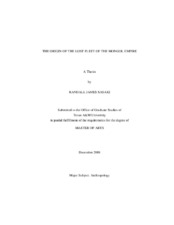| dc.description.abstract | In 1281 C.E., under the rule of Kublai Khan, the Mongols sent a fleet of more than 4000
vessels to subjugate the island nation of Japan. A powerful typhoon, called kamikaze, dashed the
invading fleet into pieces on the shores of Japan and thus saved the nation from foreign rule.
Historical sources suggest there were three principal vessel types involved in this event:
V-shaped cargo ships for transporting provisions to the front, constructed in China’s Fukien
Province; miscellaneous flat and round bottomed vessels made along the Yangtze River; and flat
bottomed landing craft from Korea.
In the recent past, the remains of the fleet were discovered at the Takashima underwater
site in western Japan, unveiling numerous artifacts including weaponry, shipboard items, and
sections of hull; however, between 1281 and the late twentieth century the site has seen major
disturbances, and the artifacts are often in poor condition. Because the site contains the remains
of ships built in China and Korea, the interpretation of the artifacts is also extremely complex. In
order to determine the origin of the vessels, a logical framework is necessary. The author has
created a timber category database, analyzed methods of joinery, and studied contemporary
approaches to shipbuilding to ascertain the origins and types of vessels that composed the
Mongol fleet. Although no conclusive statements can be made regarding the origins of the vessels, it
appears that historical documents and archaeological evidence correspond well to each other,
and that many of the remains analyzed were from smaller vessels built along the Yangtze River
Valley. Large, V-shaped cargo ships and the Korean vessels probably represent a small portion
of the timbers raised at the Takashima site. As the first research project of its kind in the region,
this study is a starting point for understanding the real story of the Mongol invasion of Japan, as
well as the history of shipbuilding in East Asia. | en |


